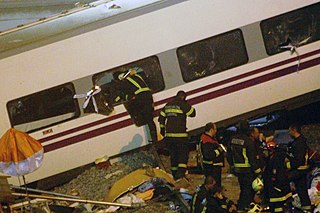Related Research Articles

The Glenbrook rail accident occurred on 2 December 1999 at 8:22 am on a curve east of Glenbrook railway station on the CityRail network between Glenbrook and Lapstone, in the Blue Mountains of New South Wales, Australia. Seven passengers were killed and 51 passengers were taken to hospital with injuries when a CityRail electric interurban train collided with the rear wagon of the long-haul Perth-to-Sydney Indian Pacific.

The Harrow and Wealdstone rail crash was a three-train collision at Harrow and Wealdstone station in Wealdstone, Middlesex during the morning rush hour of 8 October 1952. The crash resulted in 112 deaths and 340 injuries, 88 of these being detained in hospital. It remains the worst peacetime rail crash in British history and the second deadliest overall after the Quintinshill rail disaster of 1915.

On the evening of 4 December 1957, two trains crashed in dense fog on the South Eastern Main Line near Lewisham in south-east London, causing the deaths of 90 people and injuring 173. An electric train to Hayes had stopped at a signal under the bridge, and the following steam train to Ramsgate crashed into it, destroying a carriage and causing the bridge to collapse onto the steam train. The bridge had to be completely removed; it was over a week before the lines under the bridge were reopened, and another month before the bridge was rebuilt and traffic allowed over it.
Two rail accidents have occurred near Castlecary, Scotland. One of these was in 1937 and one in 1968. Both events involved rear-end collisions, and caused the deaths of 35 and 2 people respectively.

In Lockington, England on 26 July 1986, the 09:33 passenger train from Bridlington to Kingston upon Hull on the Hull to Scarborough Line struck a passenger van on a level crossing.
There have been a number of train accidents on the railway network of Victoria, Australia. Some of these are listed below.
The railways of New South Wales, Australia have had many incidents and accidents since their formation in 1831. There are close to 1000 names associated with rail-related deaths in NSW on the walls of the Australian Railway Monument in Werris Creek. Those killed were all employees of various NSW railways. The details below include deaths of employees and the general public.
The Irk Valley Junction rail crash occurred on 15 August 1953 at Collyhurst, just over a mile from Manchester Victoria station. At that point, the electrified line to Bury passes through Irk Valley Junction, so called because it lies on a viaduct above the River Irk. At 07:40 on the morning of 15 August 1953, the 07:20 electric train from Bury collided with the 07:36 steam passenger train to Bacup hauled by a Class 4P 2-6-4 tank engine. The leading electric coach struck and overturned the steam engine and smashed through the parapet wall. The front of the carriage fell 40 feet (12 m) onto the bank of the river; the rear fell 70 feet (21 m) into the shallow river itself. Nine passengers and the driver of the electric train were killed. The crash occurred on a Saturday; had it been a weekday, the casualties would likely have been far higher.
The Marden rail crash occurred on 4 January 1969 near Marden, Kent, United Kingdom, when a passenger train ran into the rear of a parcels train, having passed two signals at danger. Four people were killed and 11 were injured. One person was awarded the British Empire Medal for his part in the aftermath of the collision.
The 1956 Santiago rail crash occurred on February 14, 1956, at 4:00 a.m. near the Chilean capital Santiago on the branch to Cartagena and killed 23 people.
The Queronque rail accident was a head-on train collision that happened on February 17, 1986, on the line between Santiago and Valparaíso in Chile. It is the worst in Chilean history, killing at least 58 people.

The Santiago de Compostela derailment occurred on 24 July 2013, when an Alvia high-speed train traveling from Madrid to Ferrol, in the north-west of Spain, derailed at high speed on a bend about 4 kilometres (2.5 mi) outside of the railway station at Santiago de Compostela. Out of 222 people on board, 143 were injured and 79 died.
References
- 1 2 3 Edgar A. Haine (1993). Railroad Wrecks. pp. 148–149. ISBN 0-8453-4844-2.
- 1 2 3 "Accidente Ferroviario en San Bernardo".
- 1 2 "Accidente de Queronque". Archived from the original on 2010-01-26.
- 1 2 3 "boletin llanos de lepe2" (PDF).
- 1 2 3 "Trenes sobre rieles: Tragedias en la via".
- ↑ "Existio la Tercera Clase?".
- ↑ "Efemérides 17 de julio 2010". CostaRicaHoy.Info. Archived from the original on 2010-07-26.